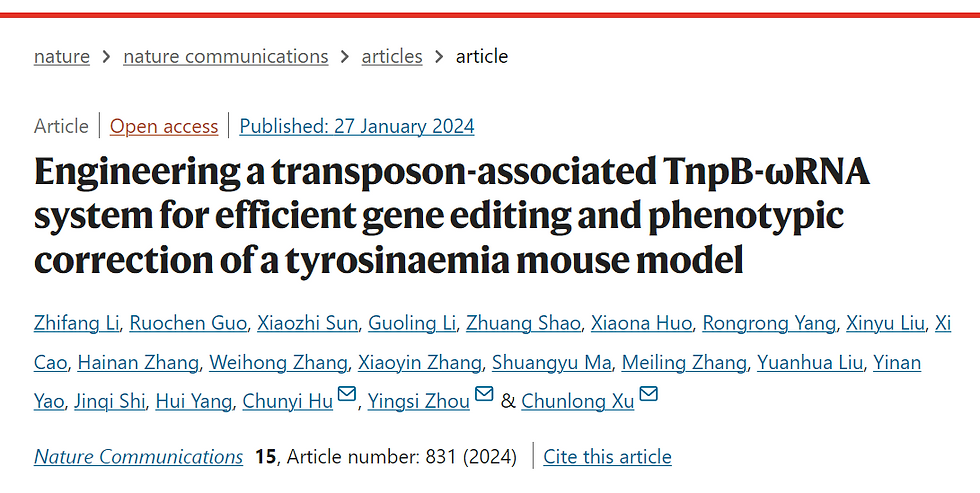Cheers, Our Newest paper was published in Nature Communications!
- hudbs3
- Jan 28, 2024
- 2 min read
Updated: Jan 28, 2024
We are thrilled to announce the publication of our latest paper in Nature Communications, a culmination of collaborative efforts with the esteemed Chunlong Xu lab from Shanghai Lingang Laboratory and Yingsi Zhou from Huida Therapeutics, Shanghai. This significant work delves into TnpB gene editing and its application in genetic disease therapy in mice. It's a remarkable achievement that underscores the beauty of scientific collaboration and discovery. We extend our heartfelt gratitude to all the collaborators for their invaluable contributions to this groundbreaking research. Cheers to this incredible milestone!
Introduction:
The Rise of TnpB and a New Chapter in Gene Editing The TnpB protein, as an ancestral enzyme of the Cas12 effector protein family, demonstrates remarkable potential in gene editing technology with its compact structure of 408 amino acids. This study delves into the gene editing activity of TnpB in mouse embryos, especially in comparison with ISDra2 TnpB from Deinococcus radiodurans, revealing its superiority over the smaller Cas12f1.
Technical Deepening:
Optimization of the TnpB-ωRNA System By engineering the TnpB-associated ωRNA, the research team significantly enhanced the nuclease activity of TnpB. This advancement is reflected not only in the effective reduction in the length of ωRNA but also in the enhanced efficiency of TnpB-mediated gene editing through precise molecular design. The successful implementation of this optimization strategy provides robust technical support for TnpB's broader application in biological and medical research.
Application Prospects:
TnpB in Disease Models Utilizing a single adeno-associated virus (AAV) delivery system, this study demonstrates the efficacy of the optimized TnpB-ωRNA system in vivo, particularly in treating a mouse model of tyrosinemia. This finding not only validates the potential of TnpB in preclinical research but also offers new therapeutic strategies for genetic therapy of hereditary diseases.
Research Depth:
Comprehensive Evaluation of TnpB's Editing Efficiency and Specificity Experimental validation across multiple genetic targets revealed that the optimized TnpB-ωRNA* (ωRNA variant) system exhibited comparable, and in some cases, superior editing efficiency to SaCas9 and SpCas9. Moreover, this study conducted an in-depth analysis of TnpB's off-target effects, using PEM-seq technology to comprehensively assess its specificity in genome-wide editing, which is crucial for evaluating the safety of TnpB in clinical applications.
Conclusion and Outlook:
The Future of TnpB in Gene Editing The research on TnpB offers a new perspective in the development of gene editing technology, especially in terms of improving editing efficiency and reducing system complexity. With further optimization and application expansion of the TnpB-ωRNA system, it is reasonable to anticipate its increasingly important role in gene therapy, disease treatment, and basic biological research. Looking ahead, TnpB could become one of the key factors in driving the further development and application of gene editing technology.





Comments